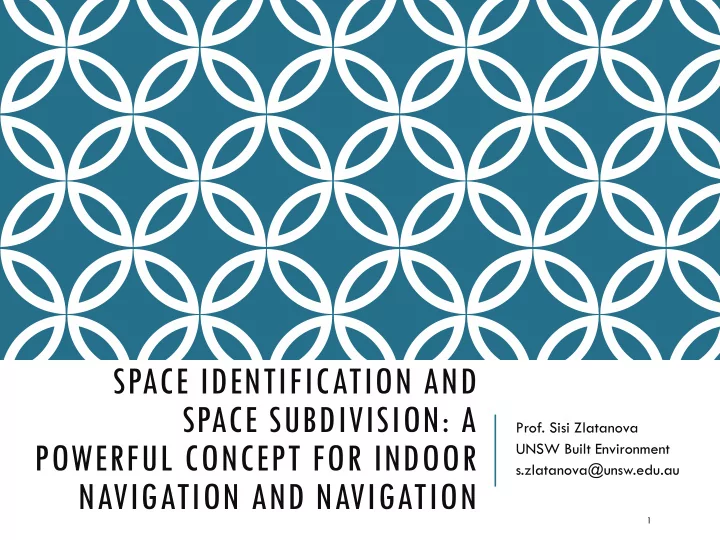

SPACE IDENTIFICATION AND SPACE SUBDIVISION: A Prof. Sisi Zlatanova POWERFUL CONCEPT FOR INDOOR UNSW Built Environment s.zlatanova@unsw.edu.au NAVIGATION AND NAVIGATION 1
CONTENT Spaces Sims3D BIM as input model Point clouds as input model Accessibility Space assisted localization
MOTIVATION Rooms are represented as single indivisible spaces or subdivided according to a geometric criteria No information on free of obstacle areas Subdivision! No descriptive localisation Semantic identification! No possibilities to navigate to those areas => no clear network pattern
WHAT DOES INFLUENCE SUBDIVISION? People: presence and their behaviour Objects in indoor environment => navigable and non-navigable areas
Indoor Space Subdivision for Indoor Navigation, 2014, Kruminaite, M. and S. Zlatanova, ISA'14, Proceedings of the Six ACM SIGSPATIAL International Workshop on Indoor Spatial Awareness, pp. 25–31
3D SUBDIVISION Navigable / Non-navigable
HOW TO IDENTIFY NAVIGABLE SPACE? Resource A Conceptual Framework of Space Subdivision for Indoor Navigation, 2013, S. Zlatanova, S., L. Liu, and G. Sithole, ISA '13 Proceedings of the Fifth ACM SIGSPATIAL International Workshop on Indoor Spatial Awareness, ACM New York, NY, USA. pp. 44-48.
SPACES: INDOORGML (2008) How to provide guidance? Geometry + Semantic = Model + Connectivity = Network + Accessibility = Context Network http://www.opengeospatial.org /standards/indoorgml (since 2014)
Green/ White: primal space INDOORGML SPACES Red: dual space Non-overlapping space subdivision Space identification ‘Thin’ door ‘Thick’ door Poincaré duality ‘Thin’ room (visibility graph) Space subdivisions
SEMANTICS More information = More possibilities PhD thesis completed 2017: Indoor Semantic Modelling for Routing Liu, L, 2017, Indoor Semantic modelling for Routing, PhD Thesis
CONTENT Spaces Sims3D BIM as input model Point clouds as input model Accessibility Space assisted localization 11
3D RECONSTRUCT & 3D SUBDIVIDE point cloud cuboid shapes final model • 3D model space subdivision network www.sims3D.net
BIM AS IMPUT MODEL 3D indoor semantic models can provide good description. IFC : The indoor spaces (IfcSpace) The furniture elements (IfcFurnishingElement) The openings (windows and doors) Spatial links between the objects
SPACE SUBDIVISION: HOW? Flexible Space Subdivision (FSS) framework. Mobility of objects: Static (S-objects) e.g. wall Semi-mobile (SM-objects) e.g. furniture, crowd Mobile (M-object) e.g. human Subspaces: Object spaces (O-Spaces) -> SM-objects Functional spaces (F-Spaces) -> SM and M-objects Remaining free spaces (R-Spaces) -> M-objects Spatial subdivision of complex indoor environments for 3D indoor navigation. 2018 A. Diakité and S. Zlatanova. International Journal of Geographical Information Science (IJGIS), Vol.32, Issue 2, pp. 213-235 14
SPACE SUBDIVISION: FFS Remaining free space
AGENT SPACES (A-SPACES) The space needed for navigation => spatial constraints of the moving agents and the resources they may carry. 16
SPACE SUBDIVISION: FFS No conflict between subspaces: priority rules Spatial relationships maintained. Special interaction with the A-Spaces. 17
CASE STUDY Object space Original BIM model Functional space 18
CASE STUDY Remaining FFS subdivision (Navigable) Space 19
WALKING, FLYING 20
NETWORK FOR PATH COMPUTATION Convex subdivision Path Computation Network Extraction 21
3D RECONSTRUCT & 3D SUBDIVIDE point cloud cuboid shapes final model • 3D model space subdivision network
ONGOING 23
3D RECONSTRUCTION Permanent structure reconstruction, wall detection Room classification Opening detection from cluttered data: door, window
SPACE PARTITIONING AND NAVIGABLE SPACE Space partitions Space partitions, walls and doors Space partitions and Space partitions and navigable space ground truth walls 25
ANOTHER VIEW Openings Space Partitions Point clouds Wall Faces Exploiting Indoor Mobile Laser Scanner Trajectories for Semantic Iterpretation of Point Clouds. 2017, S. Nikoohemat, M. Peter, S. Oude Elberink, and G. Vosselman, ISPRS Annals of Photogrammetry, Remote Sensing & Spatial Information Sciences, IV-2-W4, 355-362, 2017. (best paper young author) 26
SPACE SUBDIVISION WITH RESPECT TO WALKABLE SURFACES
Automatic Generation of Indoor Navigable Space Using a Point Cloud and its Scanner Trajectory, 2017b Bart R. Staats, Abdoulaye A. Diakité, Robert L. Voûte, and Sisi Zlatanova. ISPRS Annals of Photogrammetry, Remote Sensing & Spatial Information Sciences, IV-2-W4, 393-400
TRAJECTORY INFORMATION Removal Point cloud Voxelisation mobile objects 0.25cm
TRAJECTORY INFORMATION Projecting Region Static object trajectory on the grouing removal ground surface
SPACE SUBDIVISION
SPACE SUBDIVISION Staats, 2017, Identification of walkable space in a voxel model, derived from a point cloud and its corresponding trajectory
CONTENT Spaces Sims3D BIM as input model Point clouds as input model Accessibility Space assisted localization
INDOORGML AND LADM Rights Responsibilities Restrictions Supporting Indoor Navigation Using Access Rights to Spaces Based on Combined Use of IndoorGML and LADM Models A. Alattas, S. Zlatanova, P. Van Oosterom, E. Chatzinikolaou, C. Lemmen and K.-J. Li, ISPRS Int. J. Geo-Inf. 2017, 6(12), 384
FACULTY OF ARCHITECTURE
CONTROL THE SPACES: USE
COMMON SPACES
OFFICES (NON-ACCESSIBLE FOR STUDENTS)
PATH TO A LECTURE ROOM (COMMON SPACE + LECTURE SPACE) Next steps: space subdivision The paper got appreciated by reviewers/editors: cover story for IJGI edition 12
SPACE ASSISTED LOCALISATION Assumptions: start location is known constant speed no loops Cell phone: Wifi fingerpriniting magnetometer 40
WALKING IN ONE SPACE 41
WALKING BETWEEN TWO SPACES 42
WALKING WITH A TURN 43
LANDMARK LOCALISATION Willems, O., 2017, Exploring a pure landmark-based approach for indoor localisation 44
WHERE TO GO? Navigation in public buildings (get to rooms) Navigation to info desks/booths in exhibitions/airports (get to parts of rooms) Navigation in construction sites (changing environments) Orientation in libraries /shopping malls (finding books in shelves, finding favorite items) Maintenance/repair operations inside buildings windows/walls (failure in utilities, cleaning windows, changing carpet) Navigating to mobile facilities (finding trailers, people) Navigation for emergency response (getting out to safe place, UbiCOM getting in to rescue)
HOW TO GO? Shortest path/Fasters path Most visited route (museums) Selected items (shopping) Least turns (complex buildings) Least accessed rooms Least doors Avoid obstacles: Static, Dynamic (wait, go around, goo trough) Daisuke Takahata Consider certain size (trailer, cleaning equipment) Avoid certain areas, spaces (disable people, security) Safest (avoid dark corridors) Never get lost/alert when not on path (combine with localisation)
GEO DELFT 2018, 1-5 OCTOBER https://www.tudelft.nl/geodelft2018 1. ISPRS COM IV Spatial Information Science 2. 3D GeoInfo 3. FIG 3D cadastre 4. UDMS Smart Data Smart Cities Deadlines 31 st of March 2018
THANK YOU! QUESTIONS?
Recommend
More recommend